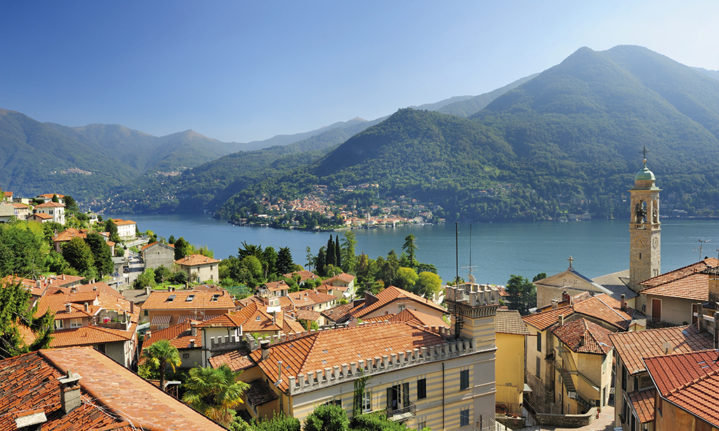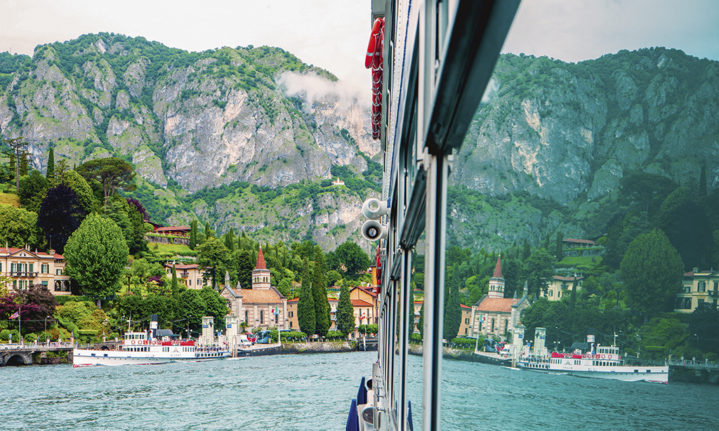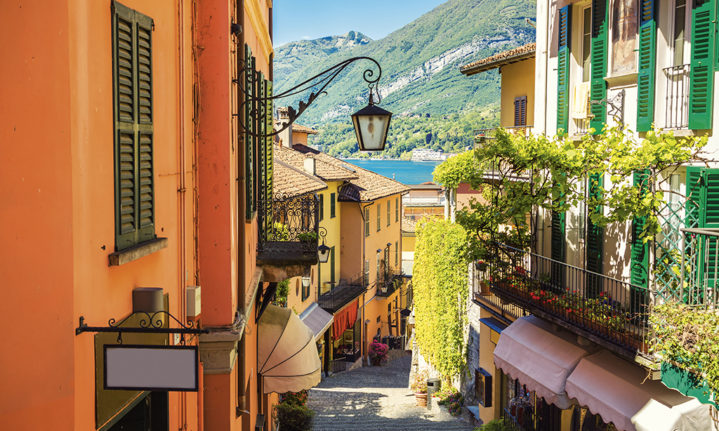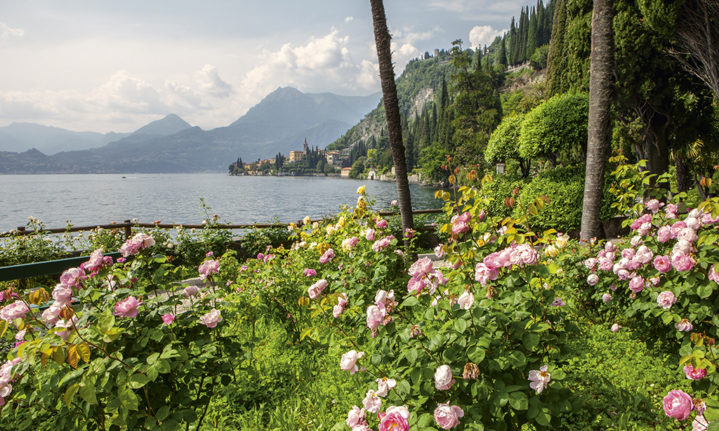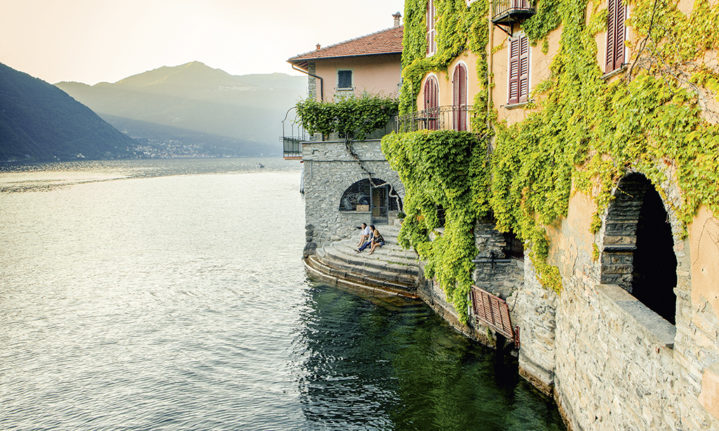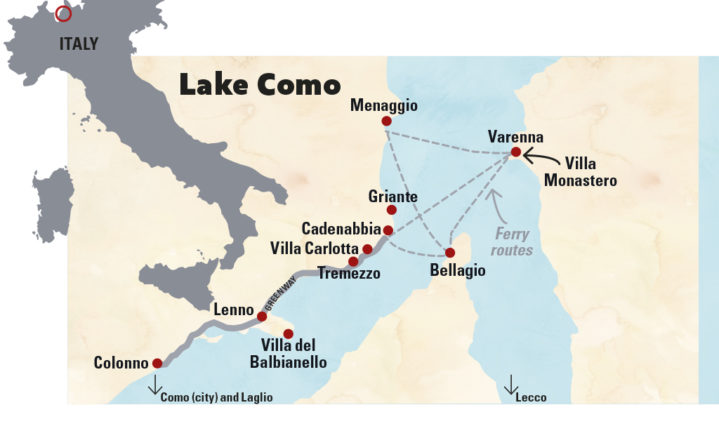
It’s a special sight every time you approach one of Lake Como’s towns or villages via ferry. Varenna, with its cobbled streets and 11th century church, is one of the best-preserved medieval centres on the lake.
The first time I saw Lake Como, Italy was while dog-sitting a university friend’s unruly French bulldog. Hanging on the wall of his entrance hall was a blown-up panoramic photo of said friend with his bride on their wedding day. They looked dazzling, standing on a manicured lawn next to an Italian fountain and a villa above a vast lake. It struck me as the sort of place reserved for celebrities. A year-and-a-half later, when I arrived on these very shores, I was surprised. There is indeed glamour all around – convoys of convertible Ferraris, motorboats topped with tanned Italians and, of course, George Clooney’s villa – but there’s another more down-to-earth side too.
My husband and I arrived at Milano Malpensa Airport in the early evening and caught a taxi (‘no Ingleesh!’). After a 90-minute drive north, we saw the lights of the lakeside villages sparkling in reflection off the dark water. The road wound high into the mountains, round impossible bends, along small back roads and down hills until, finally, we were dropped off right in front of the lake at Hotel Britannia Excelsior. The full wonder of it hit us the next morning when we walked out onto our fifth-floor balcony to a magnificent scene of indigo water, distant villages and dramatic mountains.
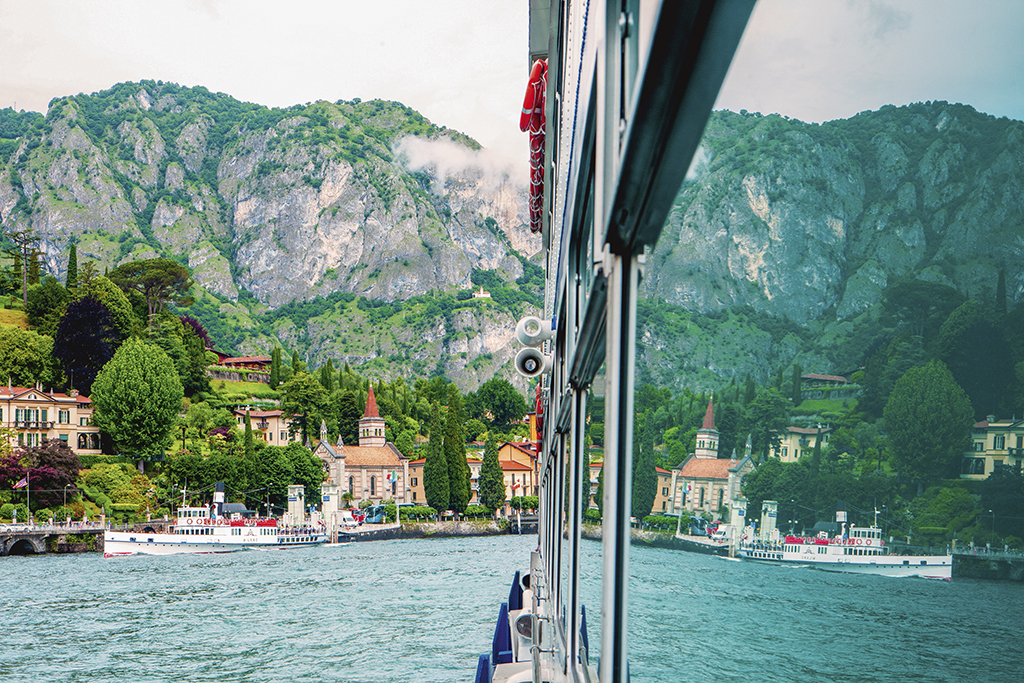
The view of Cadenabbia from the ferry – to visit the Church of San Martino, high on the hill, you’ll need to hike.
Y-shaped Lake Como is the third-largest body of water in Italy, stretches for more than 30 kilometres and boasts a temperate microclimate, which was perfectly suited to silk production. In 1400, the first mulberry trees were grown as fodder for silkworms. Factories began sprouting up around the lake, trade routes were established and the finest craftsmen in the country came to set up shop. This world-renowned silk industry brought wealth to the area and, with that, a collection of spectacular villas and gardens. This eventually led to Lake Como becoming one of Italy’s most sought-after travel destinations.
Stately Villa Carlotta was just a few minutes’ walk down the road from our hotel. Sitting majestically above the lake and surrounded by eight hectares of exquisite gardens, it’s fit for royalty. There are a number of paths to choose from – wheelchair-accessible, medium (45 minutes) and longer (90 minutes) – each taking you through the gardens and finishing at the villa. We were enchanted by the beds of flowers, valley of ferns, olive groves, and bamboo garden. The three-storey villa dates back to 1690 and over the years has had numerous owners, most notably Princess Charlotte of Prussia, who received it as a wedding gift from her mother. We marvelled at an impressive collection of art by the likes of Canova and Hayez, admired views of the lake and had a glimpse of what domestic life looked like centuries ago.

While getting lost in the alleyways of Bellagio, you’ll chance upon gelato shops, vibrant piazzas and lovely vistas at every turn.
From there, we walked down the road to the ferry stop for a 10-minute commute across the lake to the town of Bellagio (its name is the inspiration behind the famed Las Vegas hotel and casino). We wandered through winding alleyways, past silk boutiques, woodcrafting shops and gelato cafes towards the old square with its 12th-century basilica, where locals were sipping espresso and walking their dogs. We continued to the fishing harbour, then followed a steep jasmine-scented lane to the top of a hill and down the other side. Like a page out of a romantic novel, we now entered a world of cascading flowers, tweeting birds, purring cats, bobbing fishing boats and ageing Italian men chatting next to the water.
After whiling away a few productive hours in Bellagio, we boarded the ferry once again and headed for Varenna. Located at the intersection of the three branches of Lake Como, the town dates back to 769 AD and snakes from the waterline high up into the mountains. We allowed ourselves to get lost in a labyrinth of colourful alleys before finally emerging at the 14th-century Church of San Giorgio and the famous Villa Monastero, with its terraced botanical gardens. To finish off the idyllic day, we joined a throng of locals on a pebbly beach for a swim in the lake.
The next day was dedicated to hiking and there’s no better place to start than Menaggio (15 minutes by public bus from our hotel). Menaggio is a destination in its own right, comprising three villages (Loveno, Nobiallo and Croce), and offers plenty of attractions, such as the remnants of a Word War 1 defensive line, a public beach and a wide range of local eateries. Our mission, however, was to tackle one of the mountain trails (there are more than 10 in the area). We opted for a three-hour trek, which passed traditional villages, chapels and forests. Following red-and-white trail markers, the route started with a sharp ascent through the woods. Finally, our heart-pumping efforts were rewarded with views of the lake and villages far below… and the gentle tinkling of goats’ bells.
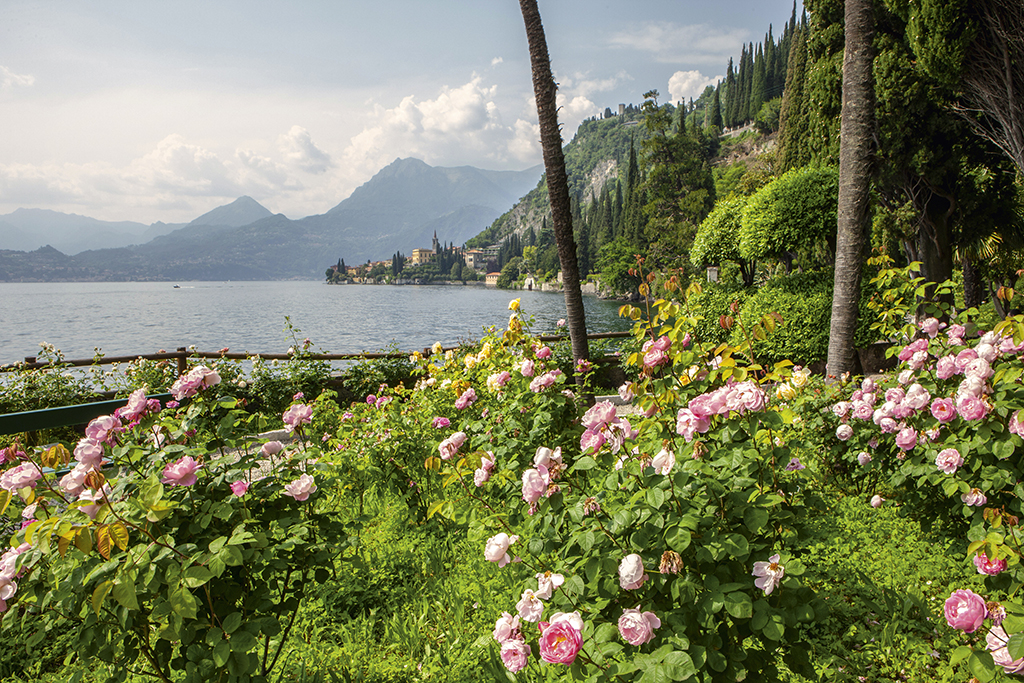
The rose garden at Villa Monastero, on the lake’s eastern shore near Varenna.
The descent zigzagged past steep cliffs and remote farmsteads, until we reached the 16th-century church of San Martino. Perched on an immense rock, it has become a sanctuary for pilgrims who frequently climb halfway up the mountain in honour of ‘Our Lady of Grace’. The final stretch down to the town of Griante was a delightful amble beneath an apple-green canopy and past mosaics depicting the Via Crucis (Stations of the Cross).That evening we rewarded ourselves with dinner in Tremezzo at a newly-opened restaurant, N26. On the menu were local specialties, including risotto sautéed with local herbs, scallop carpaccio and Iberico pork – each delectable course served with a regional wine. We dedicated our last day to the Greenway. Stretching from Griante to Colonno, this leisurely 10-kilometre route was designed by local municipalities to guide visitors to ancient villages, remnants of Roman antiquity, villas and gardens. We set off on foot from our hotel and headed along the lakeshore, following ‘Greenway’ copper plaques embedded in the pavement. We walked through public parks and vibrant town centres, past football players in action and along pretty marinas flanked by cafes.
Halfway, we paused at Villa del Balbianello. Sited on a peninsula and surrounded by Roman sculptures and lush gardens, this magnificent 18th-century mansion has a library of 4,000 books, artefacts from early African, Aztec and Mayan civilisations, and souvenirs from historic expeditions to the North Pole and Mount Everest. Its last owner, Count Guido Monzino, was a passionate traveller and the leader of the first Italian expedition to scale this mountain. The rest of the Greenway took us through elevated villages with vast views of the lake, along sections of the Strada Regina, an ancient Roman road, and down into Colonno, where we once again dunked our tired bodies in the lake.

The village of Nesso on the eastern branch of the lake – from a bridge in the town, you can glimpse the waterfall that divides the village in two.
On our final evening, I stood on our hotel balcony watching a summer storm brewing. Big raindrops began to splash down and lightning lit up the lake. I marvelled at how, during our stay, Lake Como had been connecting us to the elements. Life here revolves around water, mountains, the weather and the earth. With this comes a feeling of harmony and balance. Even the aristocrats of yesteryear, who flocked here to see and be seen among the rich and famous, must have left feeling more grounded. We most certainly did.
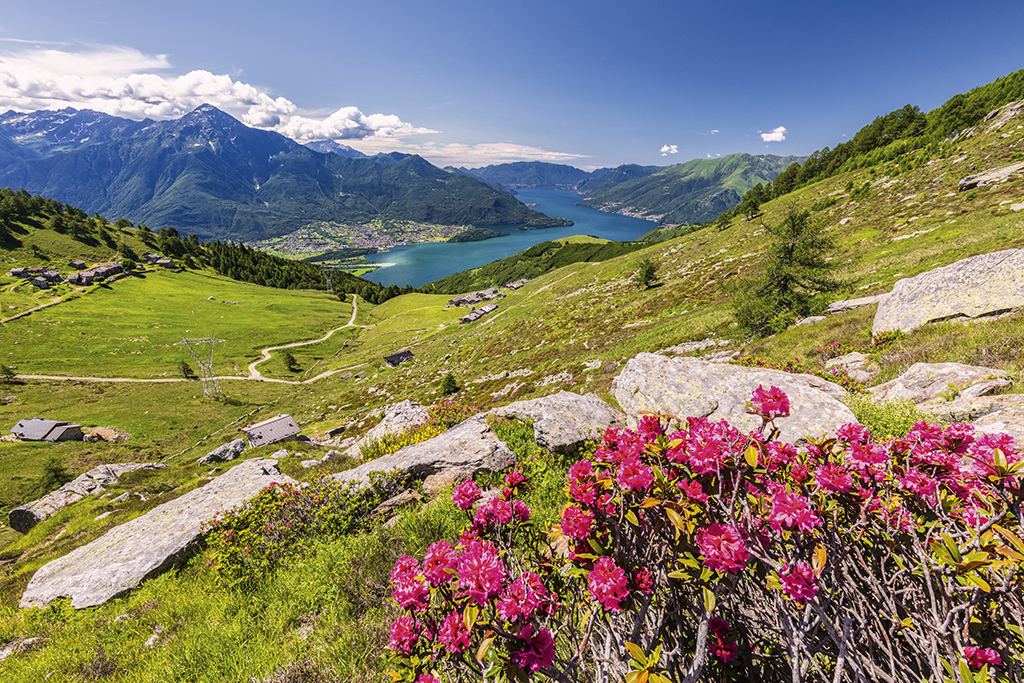
Lake Como is a hikers’ paradise, with dozens of routes to choose from. During a hike from Menaggio, we found working farmsteads at the very top of the mountain.
Plan Your Trip
Getting There
Alitalia flies from Joburg to Milan with a stopover in Rome (from R11,400 per person, alitalia.com). The taxi to Lake Como (which can be pre-booked, milanomalpensa-airport.com) takes up to 90 minutes and costs around R1,450 (€90). Or catch a train from the airport for R160 per person (€10) to the city of Como, and take a taxi or boat from there. See welcomepickups.com for info.
When to Go
Any time between March and November is good; sunshine (and crowds) are guaranteed in July and August.
Need To Know
Ferries connect Varenna, Bellagio, Menaggio and Cadenabbia. Single trips cost R74 per person (€4,60); a one-day pass costs R240 (€15), a six-day pass is R725 (€45). navigazionelaghi.it Our bus fare from our hotel in Cadenabbia to Menaggio cost around R20 one way. There are plenty of outdoor activities that don’t cost a cent. The local tourism offices (visitcomo.eu) provide detailed maps of hiking routes, while swimming spots can be found all along the lake. (Some hotels have private beaches but for the most part the shoreline is open to anyone.) Always check prices before ordering food or you’ll probably be overcharged.
Stay Here
Lake Como offers every kind of accommodation, including camping and Airbnb stays.
Hotel Britannia Excelsior is a three-star option in Cadenabbia, converted from a 19th-century inn and 50 metres from the ferry stop. It has a resort vibe, with two pools, restaurants and bars. Standard room from R1,770 for two (€110); with a lake view R1,930 for two (€120). hotelbritanniacadenabbia.com
Hotel Bazzoni in Tremezzo is very similar – it overlooks the lake and has bars, restaurants and a pool. From R1,935 for two (€120). comovita.com Comovita also has a portfolio of holiday-home rentals. From R1,200 for two (€90).
Do This
Explore the three iconic lake towns. Also known as the ‘golden triangle’, Bellagio, Menaggio and Varenna are 10 to 15 minutes apart via ferry. bellagiolakecomo.com, discovercomo.com
Visit a few famous villas and gardens. Allow at least two hours for the full experience. Villa Carlotta is near Tremezzo (villacarlotta.it); Villa del Balbianello is on the Lavedo peninsula near Lenno; Villa Monastero is south of Varenna and visiting just the botanical garden is cheaper (villamonastero.eu). Entry fees are usually R160 pp (€10).
Walk the Greenway. This well-marked, 10km lakeside route on the western shore is a fantastic way to explore local hamlets, villages and towns (it passes through seven). It takes up to four hours to walk the whole trail, but there are boat and bus stops if you want to opt out. greenwaylagodicomo.com
See George Clooney’s house. Head south to the small town of Laglio and look out for Villa L’Oleandra, which appeared in Ocean’s Twelve.
Learn about silk. For the history of silk production, the Silk Museum (Museo Seta Como) is in the city of Como. Entry R160 pp (€10). Closed on Mondays. museosetacomo.com
Eat Here
Every town has several gelaterias. The average price for two scoops is R32 (€2).
N26 is at the Hotel Bazzoni in Tremezzo. It has terrace seating overlooking the lake and does classic Italian cuisine (the chef was born in Como). Dishes average around R190 (€12). n26tremezzo.com
Pizzeria Lugano in Menaggio is a local hang-out tucked away in an alley (Via Como). The delicious thin-crust, wood-fired pizzas cost around R113 (€7). Note that it’s open for lunch until 2.30pm, then again from 6.30 to 10.30pm.
Le Specialità Lariane is a food shop on Via Lavedo in Lenno. The lake fishermen deliver their catch here, to be smoked, salted and marinated to perfection.
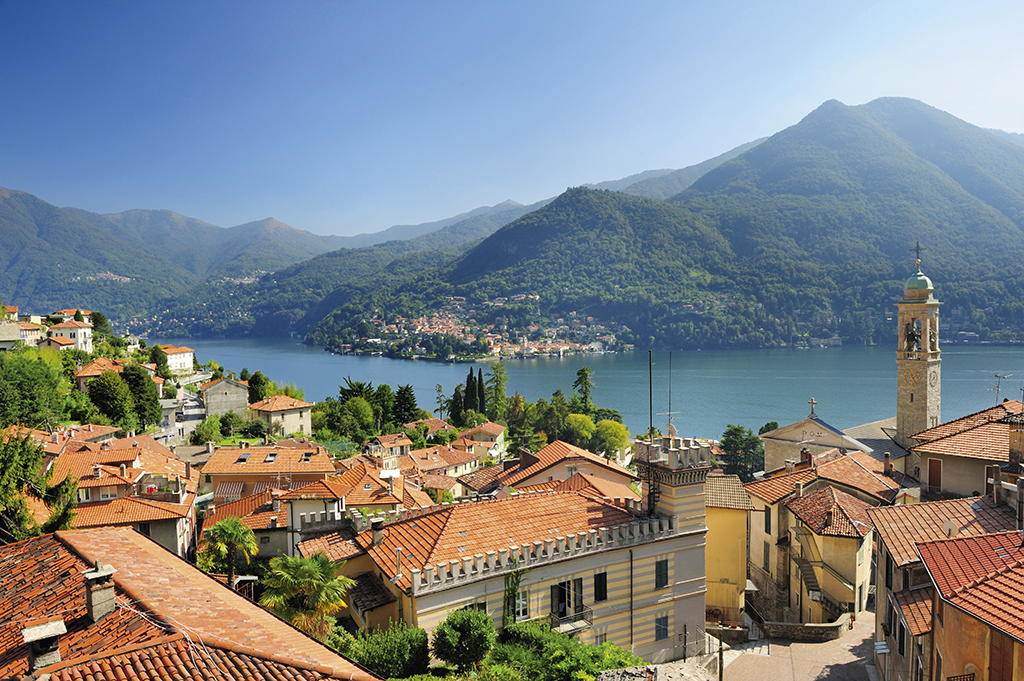
Walking the Greenway route gave us insight into the everyday life of people living in ancient villages.
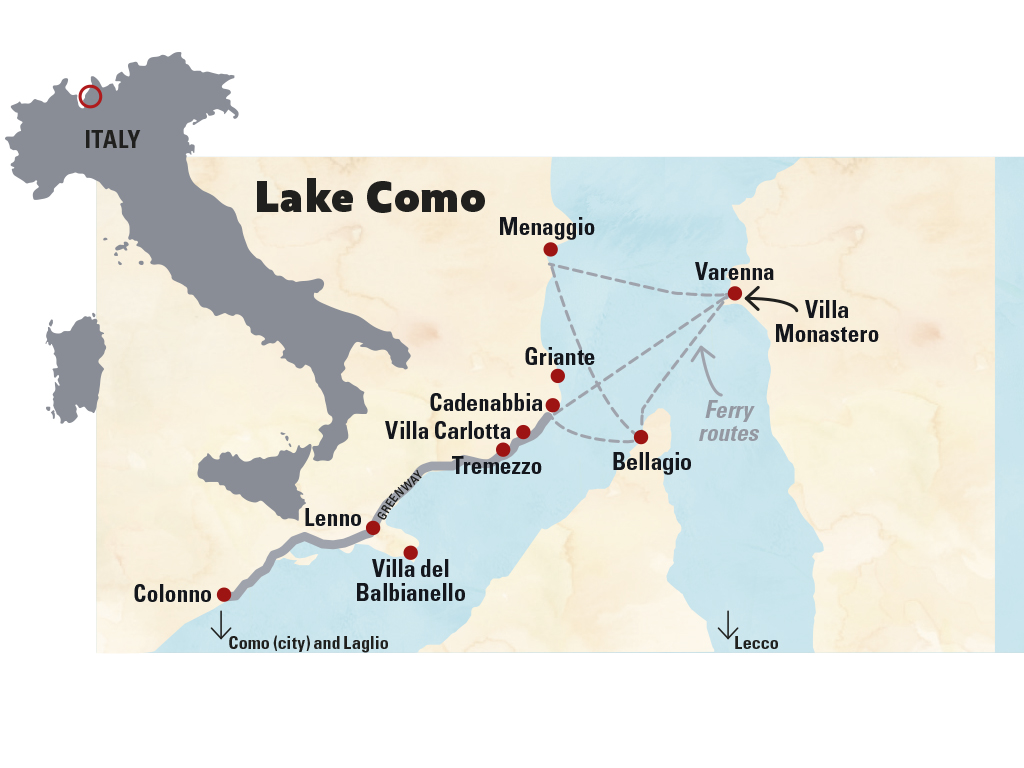
Words and photos: Franki Clemens









